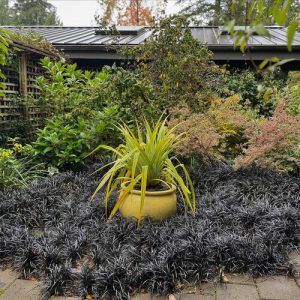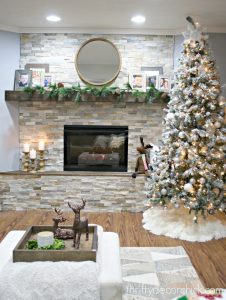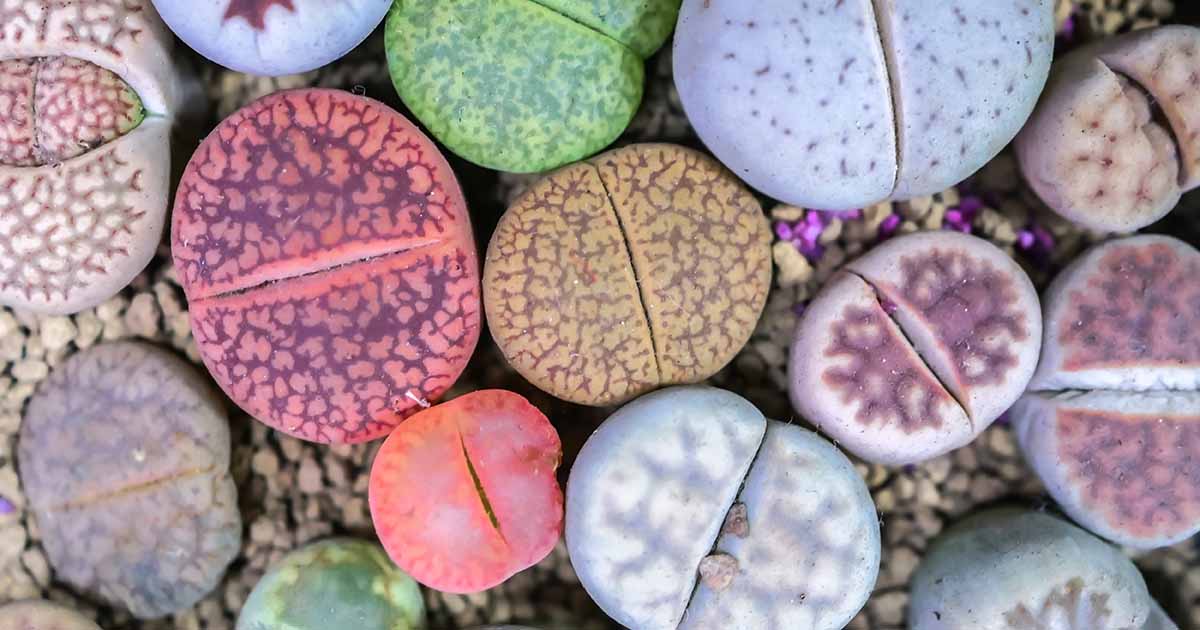
Lithops are fascinating little plants that mimic stones to survive in harsh climates – and there are many captivating species, subspecies, varieties, and cultivars!
Depending on who you ask, there are approximately 37 species of lithops out there, not to mention the many subspecies, naturally occurring varieties, and cultivars.

We link to vendors to help you find relevant products. If you buy from one of our links, we may earn a commission.
We’re going to learn what’s so special about those 37 species of lithops – and get some glimpses of a few lithops subspecies and cultivars as well.
Whether you want to add a living stone to your succulent collection or are just interested to see what this incredible genus has cooked up evolutionarily speaking, you’ll certainly enjoy browsing this “rock” collection!
Here’s a sneak peek:
37 Types of Lithops Succulents
We’ll be looking at the characteristics that define each of these lithops species, including body shape, flower color, the number of heads to expect on mature specimens, face shape and texture, depth of the fissure, colors, whether windows are visible or not, and markings such as margins, channels, and rubrications.
If any of those terms are unfamiliar to you, you might want to brush up on your lithops lingo by reading our complete guide to growing and caring for living stones!
We’ll also look at mature sizes for the heads of each species, from tiny to very large. Remember, we’re talking about diminutive lithops plants here, so those sizes are relative! Here are the measurements you can expect:
- Tiny: less than roughly half an inch
- Small: about half an inch to three quarters of an inch
- Medium: around three quarters of an inch to one inch
- Large: approximately one inch to an inch and a quarter
- Very large: up to an inch and a half wide
For some of these species, we’ll also talk about water needs. Hailing from extremely arid locations, lithops bloom and produce new leaves seasonally, based on the availability of water in the locations in southern Africa where they evolved.
Most species should be watered from approximately late spring to early summer and from late summer to autumn. However, there are some exceptions – those that have different seasonal water needs are noted here.
Let me preface this tour of the Lithops genus by saying that if you’re the type of person who likes to know exactly what you’re going to get in a houseplant appearance-wise, these succulents may not be the best choice for you!
There is an incredible amount of variation among these tiny plants, even within a given subspecies or variety.
Most likely, this diversity is part of lithops’ strategy to camouflage themselves as stones, blending into the scenery so that they aren’t noticeable by herbivores. Rocks and pebbles don’t all look the same either do they?
Now that you know what to expect and are prepared to embrace ambiguity, let’s start exploring the world of living stones!
1. Amicorum
Named for a group of four amical friends who introduced this plant to the world of horticulture, some now consider L. amicorum to be a subspecies of L. karasmontana, a species we’ll encounter later in this article.
With slightly convex lobes, L. amicorum usually produces two to four heads at maturity and is one of the tiniest living stones in the Lithops genus.

From a top down view, the two faces together create an elliptical shape, and are smooth with a deep fissure between them.
Colored grayish, beige, pinkish-gray, or blueish-white, L. amicorum has wide, opaque windows that are beige or gray with many islands.
The margins on this lithops are discernible, but it usually has no channels. This succulent sometimes has rubrications or red dots, and produces white flowers.
2. Aucampiae
Winner of the RHS Award of Garden Merit in 2002, L. aucampiae (also known as L. turbiniformis) is more or less flat topped or slightly convex, and has unequal lobes.
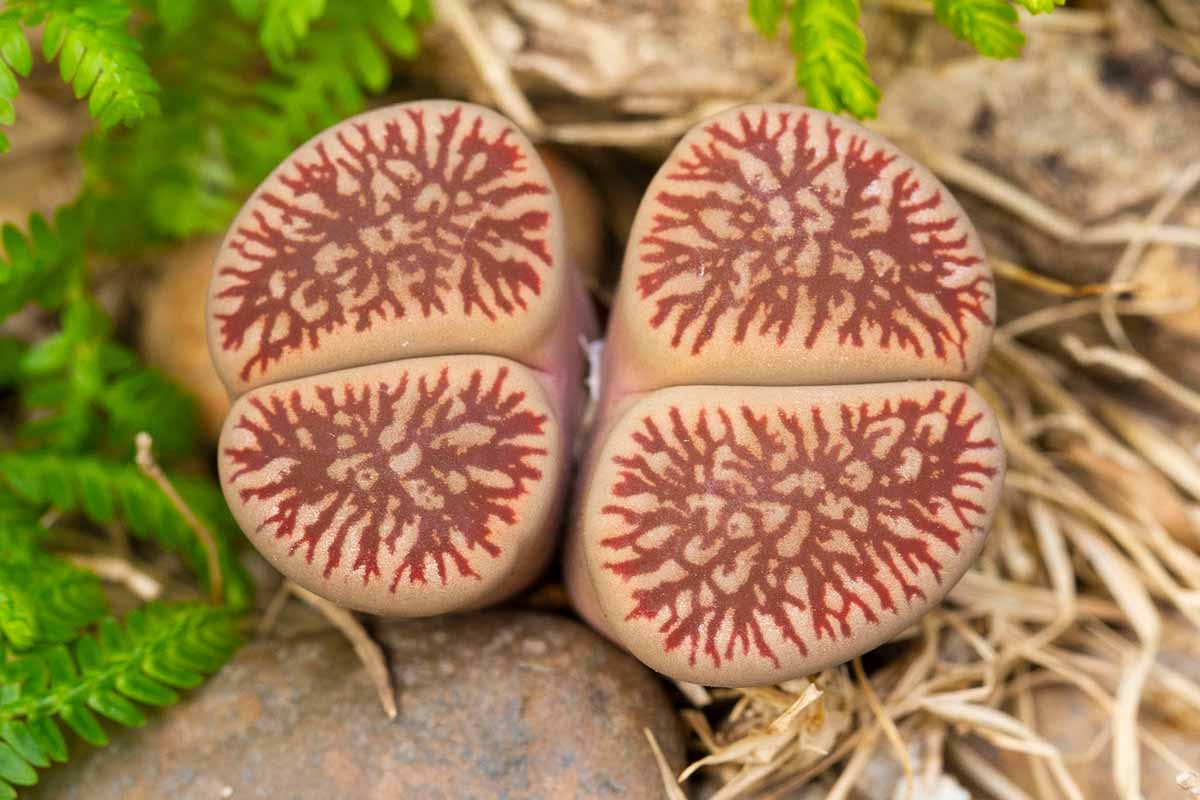
This living stone usually produces two to five heads, but older specimens can sometimes produce 12 or more.
Kidney shaped faces have a smooth or slightly rough surface, and are separated by a shallow cleft.
Producing very large heads, L. aucampiae tends to have brownish-red bodies with translucent yellowish to reddish brown windows, sometimes in the form of branching channels.
Its margins are usually distinct as are its islands. These islands tend to be small and can be yellowish, greenish, or pinkish-gray, and are sometimes raised.
L. aucampiae has no rubrications, and it may have dusky dots, but they are usually not obvious.
This lithops is graced with yellow flowers.
L. Aucampiae Lithops Seedlings
You can purchase sets of two live L. aucampiae lithops seedlings from Micro Landscape Design via Amazon.
3. Bromfieldii
Another winner of the RHS Award of Garden Merit in 2002, L. bromfieldii has a flat-topped or slightly convex profile.
This living stone can bear just one head, or multiple heads of two to 10 or more.
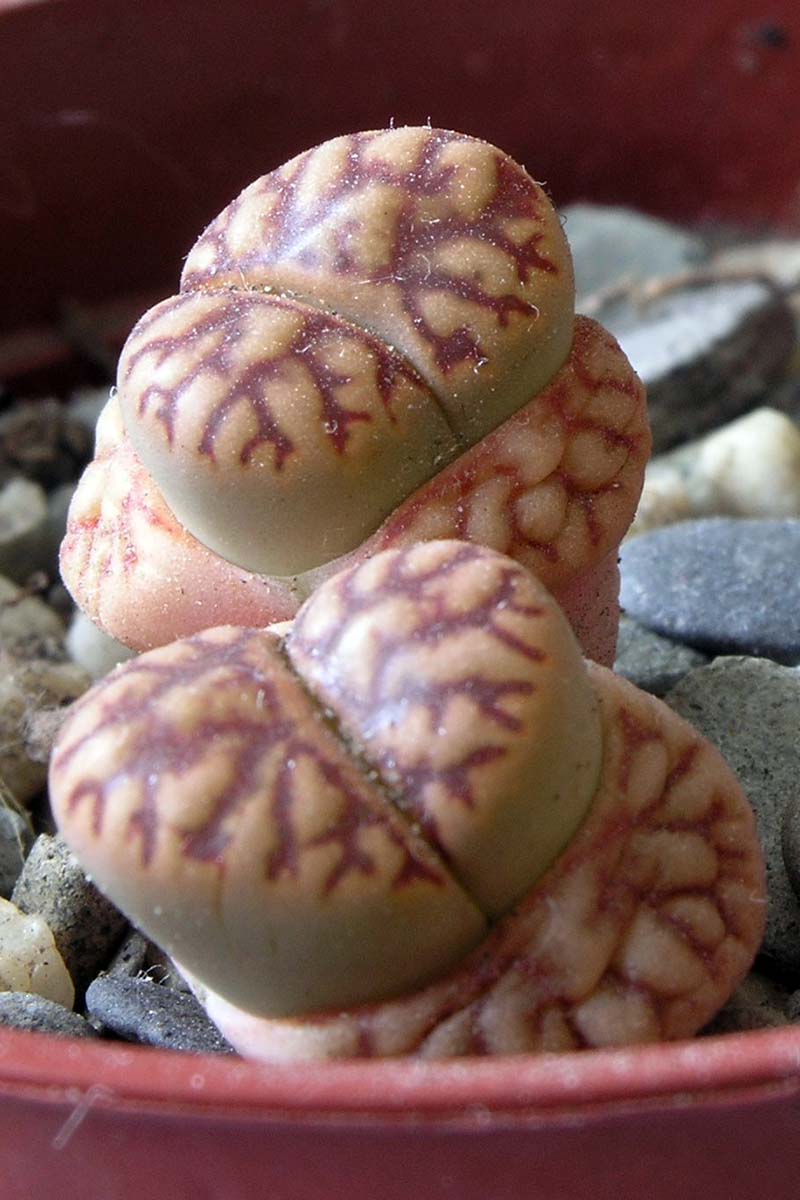
With kidney-shaped faces separated by a shallow cleft, L. bromfieldii has textured face surfaces with raised islands and sunken channels.
This medium-sized living stone is found in pale shades of pinkish-yellow, cream, orangish-yellow, or pinkish-gray. The windows of this lithops are usually mostly obscured, though sometimes olive green windows are visible.
With distinct margins, L. bromfieldii has bold rubrications that create a network of branching red lines in its furrowed channels. It bears yellow flowers.
‘Ember’ is a cultivar of L. bromfieldii var. glaudinae that has a reddish purple body.
L. Bromfieldii var. Glaudinae ‘Ember’
You can purchase a small or medium sized, live ‘Ember’ living stone plant from the Micro Landscape Design Store via Amazon.
4. Coleorum
L. coleorum usually has convex lobes, and usually just two heads, but sometimes up to eight.
With smooth, kidney-shaped faces and a deep fissure, this lithops is a small species in shades of pale creamy brown with a pink or green tinge.
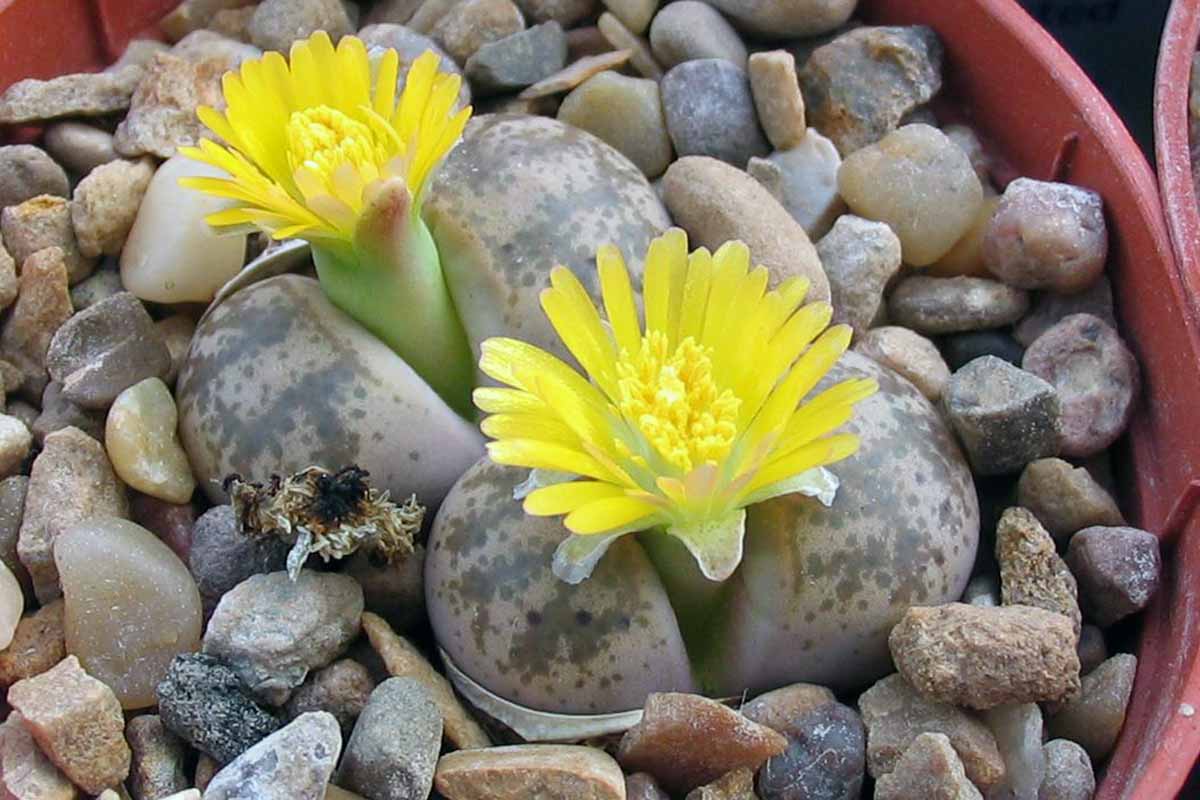
Windows take the form of broad to narrow channels, and margins are not well defined.
There are no rubrications on this lithops, but it has many distinct dusky dots and produces bright yellow flowers.
5. Comptonii
L. compotonii has convex lobes on a heart shaped body profile.
This lithops usually produces only single heads, but sometimes will bear two or four, and occasionally up to 15.

Faces are semi-elliptical to kidney shaped and have a smooth or slightly rough texture with a deep fissure between lobes.
This medium sized living stone appears in dark green, purplish-green, or purplish-red, and has brown to purple windows dotted with islands that are pinkish-beige, light gray, or pale greenish-gray.
L. compotonii has distinct, toothed, grayish-green outer margins, and inner margins that are lobed.
This lithops’ channels are broad to narrow, it lacks rubrications, and bears lovely yellow flowers with white centers.
6. Dinteri
L. dinteri is flat topped or slightly convex in profile, with lobes of equal size.
This small lithops can appear with just a single head or in clumps of two or three, but sometimes produces more than seven heads.
Its faces are smooth to the touch, and rectangular shaped when viewed from above, with a shallow cleft between the two lobes.
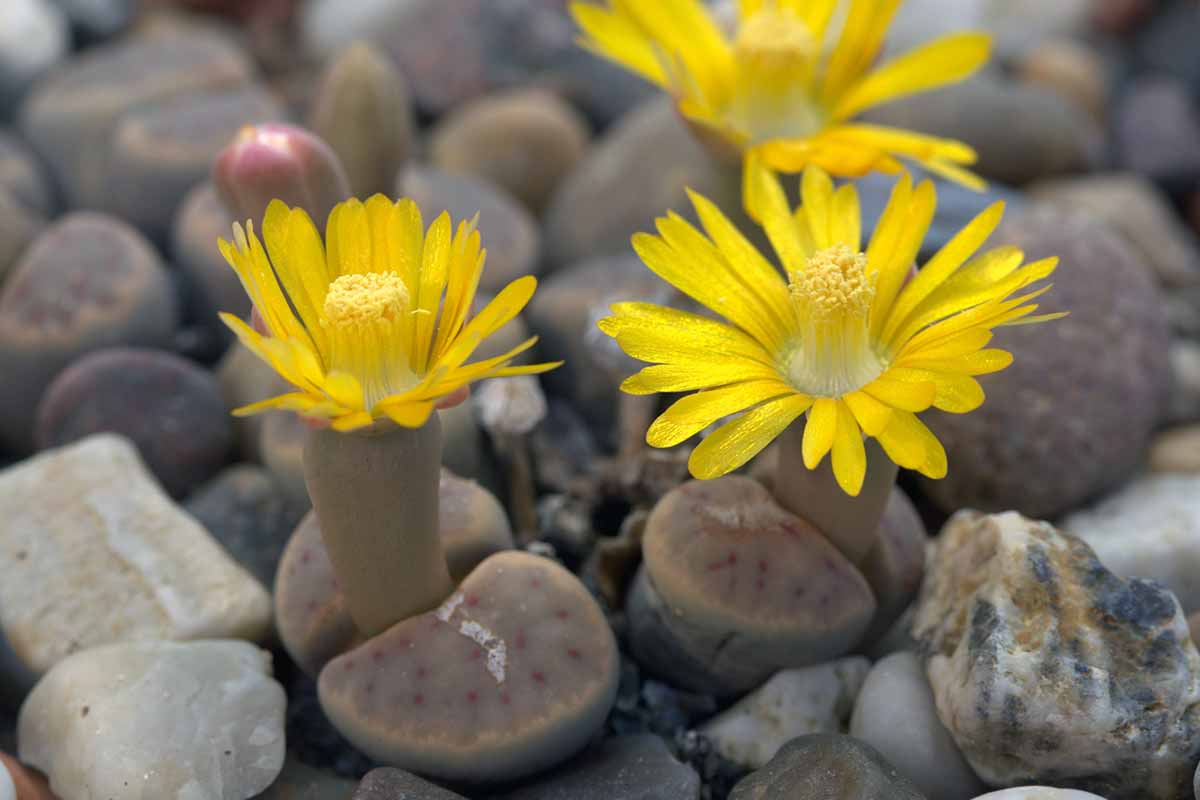
With pale green, gray, pink, or brown faces and purplish-green sides, this living stone has large windows that are usually a translucent brownish-green.
With distinct margins, the inner margin is mostly straight, there are no islands, and usually no channels.
Instead, this living stone features bright red dots on the surface of the window, and sometimes red dashes or hooks as well.
L. dinteri bears a beautiful yellow flower.
7. Divergens
L. divergens has a double wedge shaped profile and usually grows in clumps of two to four heads, but is sometimes solitary and sometimes produces 10 heads or more.
Faces are half-moon shaped, with one lobe bigger than the other and surfaces that look wrinkled but are smooth or slightly rough.

The fissure is deep, and this small succulent has a wide fissure as well, with lobes sometimes quite separate from each other. They grow farther apart as the plants mature.
L. divergens can appear in pink, whitish-green, grayish-green, or grayish-brown, and has large windows that have a mottled appearance.
Its margins are very narrow, and it has islands that are very small, indistinct, and opaque, tinted pale shades of blue, pink, green, or gray.
L. divergens has narrow and indistinct channels, no rubrications, and produces yellow flowers with white centers.
Of note, this lithops should be watered from fall through early spring.
You can purchase packs of 100 L. divergens lithops seeds from FTG Goods, via Amazon.
8. Dorotheae
Another winner of the RHS Award of Garden Merit, this time in 2012, some consider L. dorotheae not a distinct species but a variety or subspecies of L. dinteri.
We’ll let the taxonomists worry about that – we can still enjoy its distinctive beauty!
This lithops has flat-topped lobes with a heart shaped profile, and usually produces two to five heads, but sometimes seven or more.
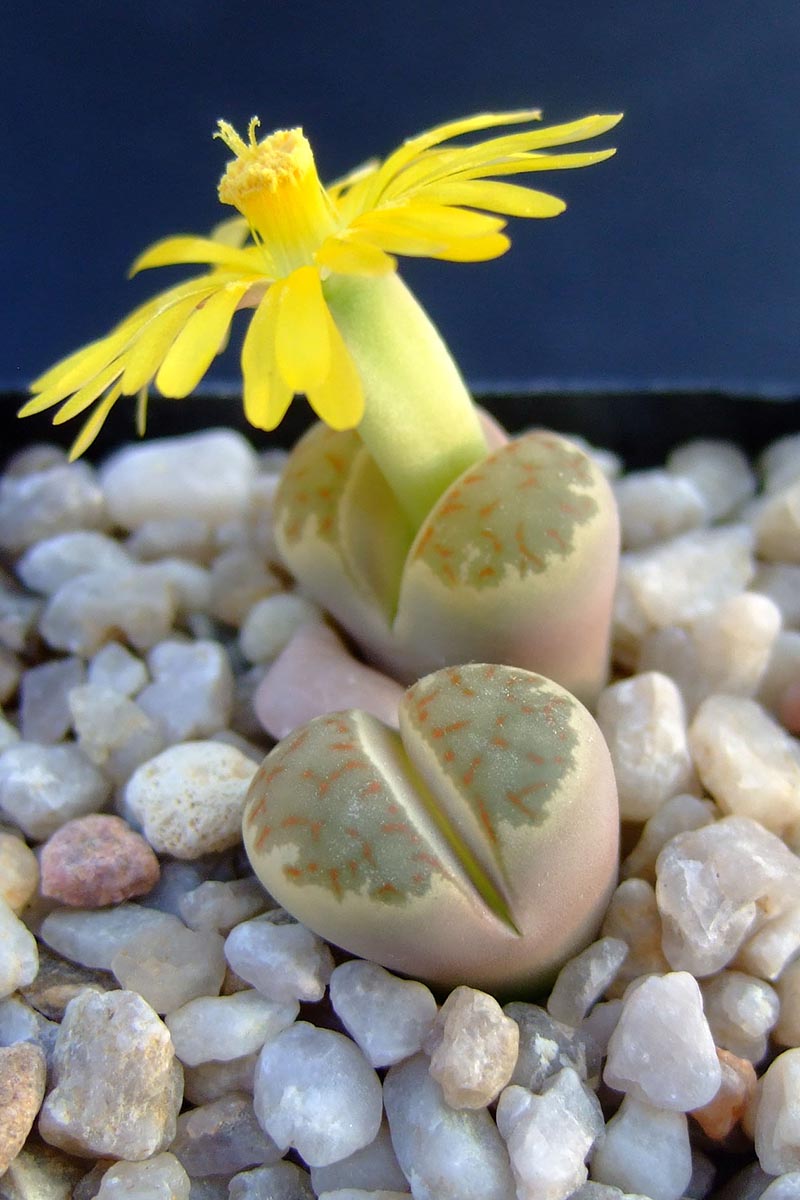
Faces are smooth and kidney shaped, with lobes separated by a shallow cleft.
This small living stone appears in creamy yellowish-pink to beige tones.
Windows take the shape of broad to narrow channels that are reddish-brown, brownish-green, reddish-green, or greenish-gray in color, and are scattered with small to large islands.
Margins and islands are opaque, colored a creamy shade of beige tinged with yellow, pink, or green.
With rubrications in the form of lines, dots, hooks, or stars, this lithops bears yellow flowers.
Purchase a set of three live L. dorotheae living stones in small, medium, or large sizes, from the Micro Landscape Design Store via Amazon.
9. Francisci
L. francisci has a heart shaped body and convex, elongated lobes that aren’t as flush with the ground as some other species.
This living stone grows in clumps of three to six heads, but sometimes as many as 20.
Its faces are kidney shaped to semi-elliptic, unequal in size, and smooth or just barely rough.
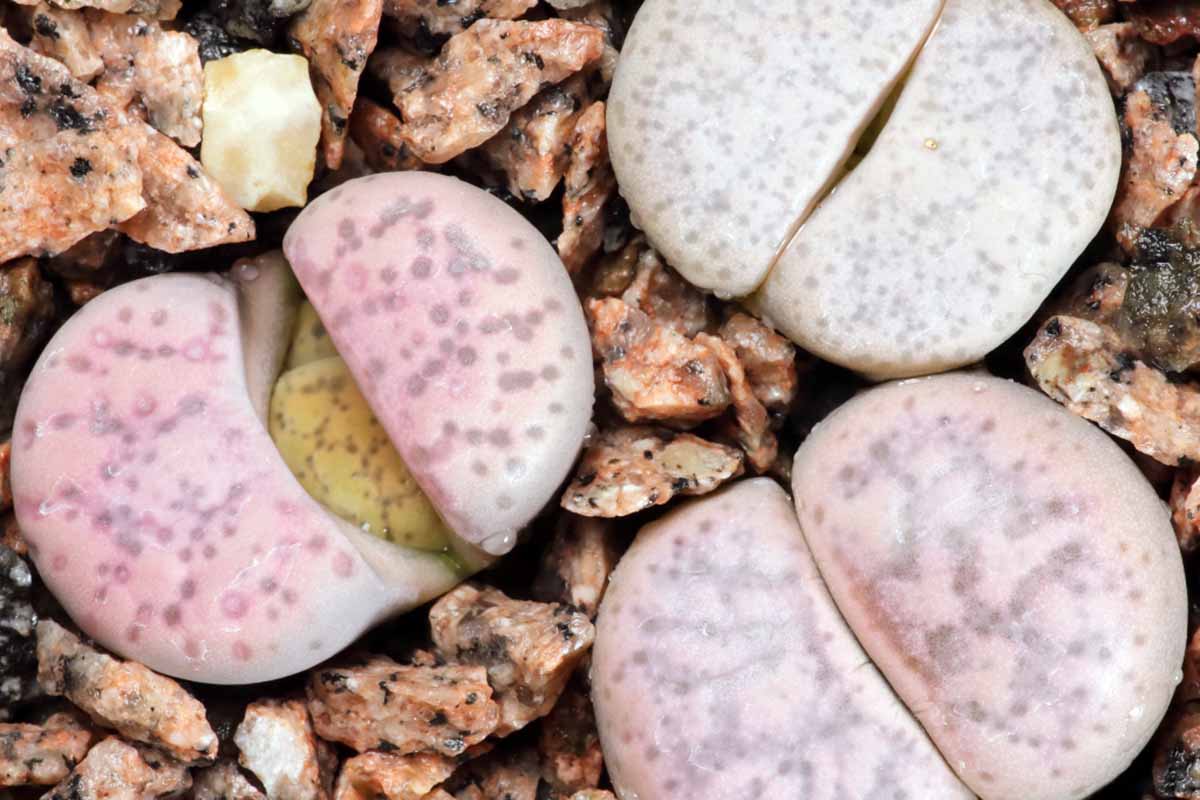
With a deep fissure, this small to medium sized living stone appears in beige, cream, or pale gray, sometimes tinted with green, pink, or yellow.
The windows are usually hidden behind an opaque looking surface, margins are usually not apparent, and islands are indistinct.
Faint, narrow channels are indented in the surface and are often grayish-green. Dusky dots in L. francisci are very numerous, indented, and colored dull green or gray.
Don’t expect any rubrications from this living stone – but do expect bright yellow flowers.
It’s best to water this lithops from fall through winter, as it would receive in its natural habitat. Water lightly with a spray bottle.
10. Fulviceps
L. fulviceps has a flat topped, heart shaped profile with flush faces and usually produces two to three heads but sometimes up to 10.
With kidney shaped faces that are slightly rough, this medium to large lithops has a shallow cleft between its two lobes.

L. fulviceps is found in shades of rusty yellow brown, orange brown, red brown, or gray brown with hints of green, purple, or pink.
Windows, margins, islands, and channels are usually absent or unnoticeable but rubrications are present in the form of dots, dashes, or branching lines.
This lithops has a distinguishing characteristic – the many raised, dusky dots spread over its faces, which can be dark gray, brown, or purple.
Expect yellow flowers from L. fulviceps.
11. Gesinae
With a heart shaped profile, L. gesinae produces one or two heads, or sometimes up to 10.
It has smooth, semi-elliptic or slightly kidney shaped faces separated by a deep fissure and fairly wide gap.
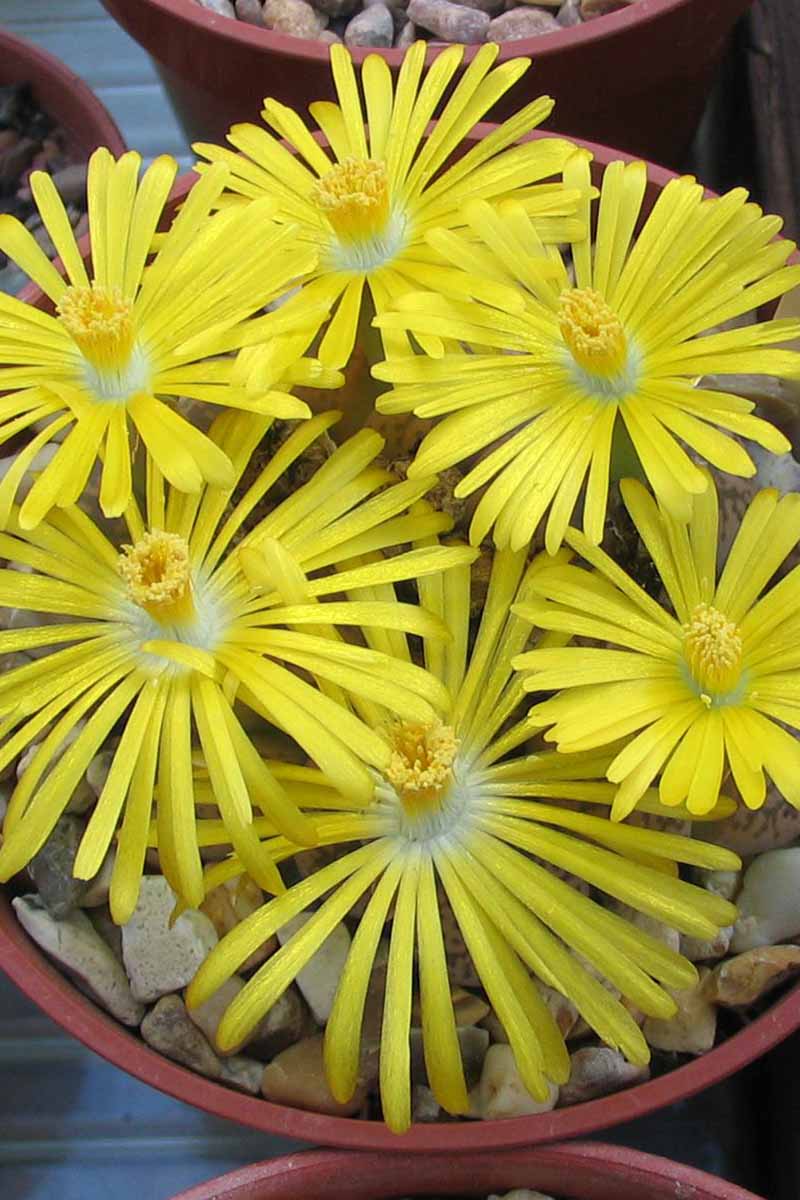
In shades of pinkish-gray, greenish-brown, or pinkish-brown, this small to large lithops usually has obstructed windows.
This lithops’ margins are usually distinct, as are its small to large islands which are pink, grayish-pink, or yellow.
Brownish-green to grayish-green channels are narrow to broad, rubrications are absent, and flowers are yellow.
12. Geyeri
With a heart shaped profile, L. geyeri has convex lobes and grows as a single head, in clumps of two to seven, or sometimes 12 or more.
Faces are semi-elliptic with a more or less smooth surface and a fairly deep cleft.
In small to large sizes, L. geyeri is gray to beige in color with windows that are usually large, and may be shades of dark green, brown, or gray.
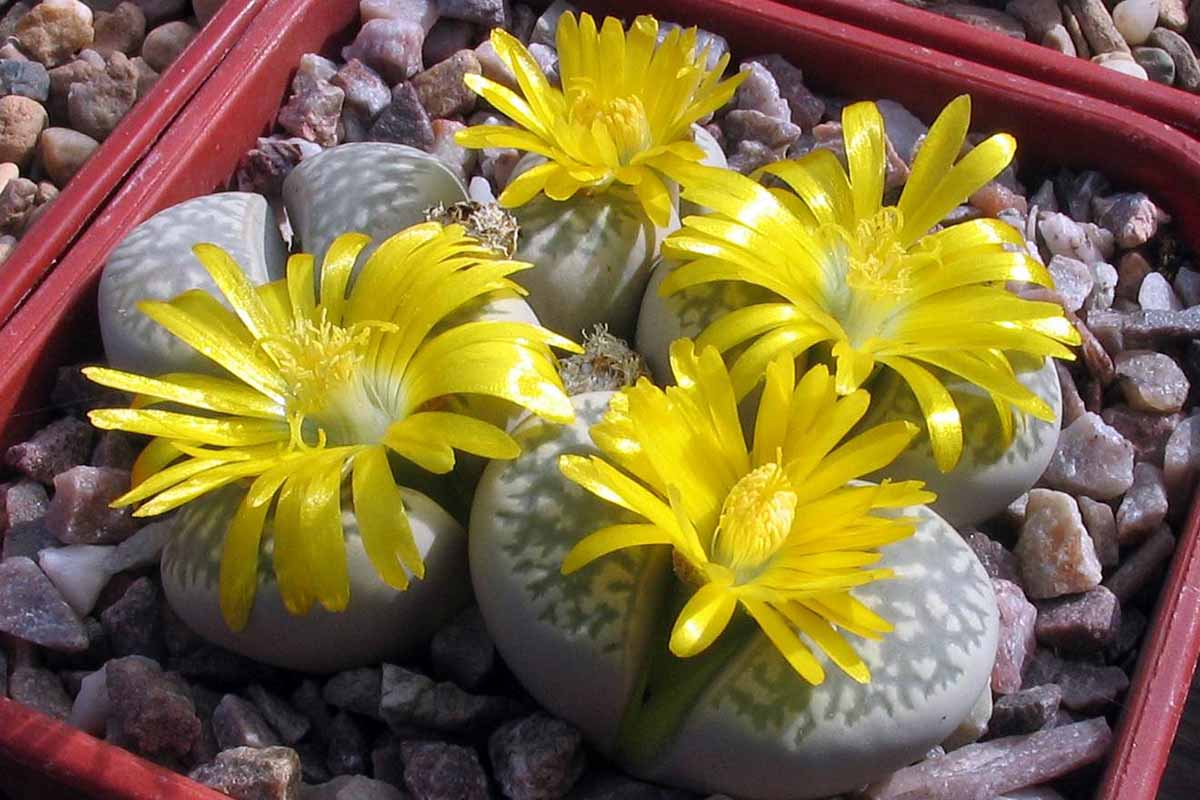
This lithops has distinct margins, and its islands are usually indistinct flecks – these are beige or milky gray, sometimes with hints of cream, pink, or yellow.
Channels are broad to narrow, colored pale blue, gray, brownish-green, greenish-gray, or grayish-green.
While there are no rubrications on this succulent, it has dusky dots which are a dull grayish-green and yellow flowers that sometimes have white centers.
This is another living stone that is better adapted to receiving water from fall to late winter, and should be watered lightly with a spray bottle.
You can grow your own – purchase packs of 30 L. geyeri living stone seeds from FTG Goods via Amazon.
13. Gracilidelineata
With a flat or slightly convex profile, L. gracilidelineata usually produces a solitary head.
With faces that are half circles to semi-elliptic and usually rough, this living stone is large to very large and has a shallow cleft between lobes.
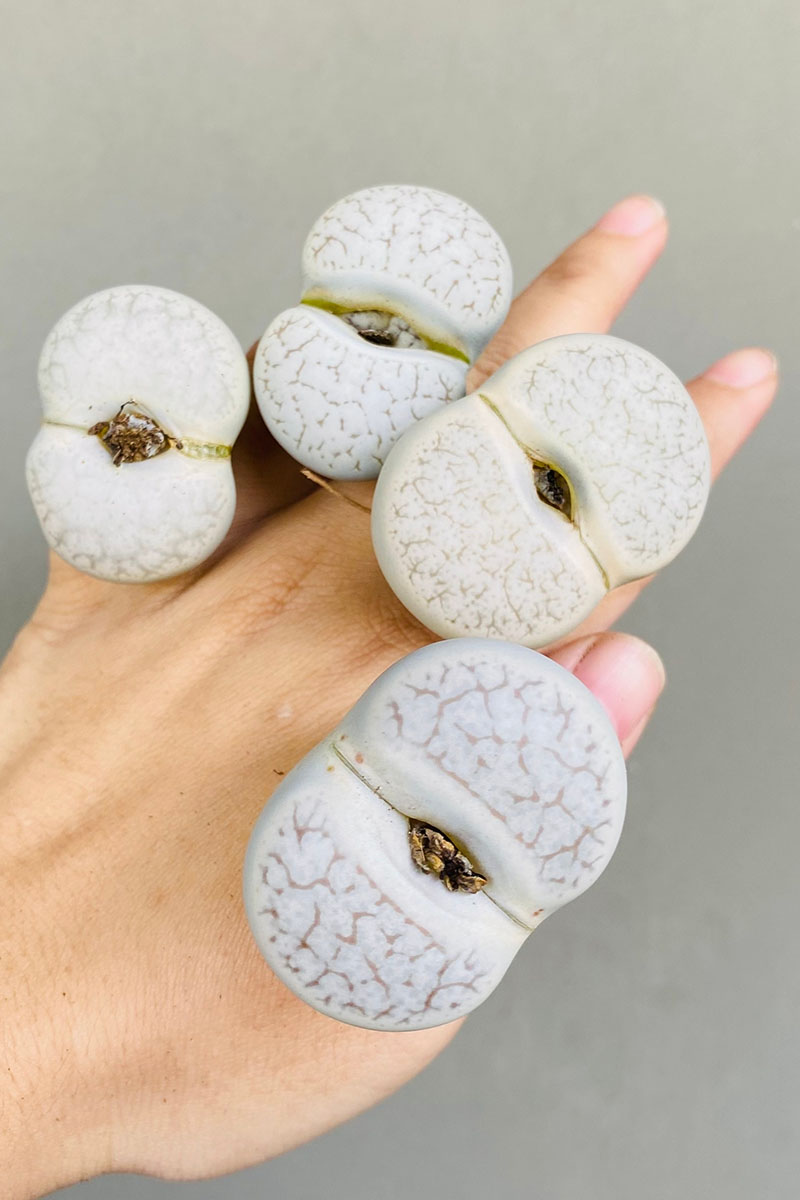
Face colors are usually opaque and pale shades of grayish white, gray, blue, yellow, or pink, sometimes tinged with beige or brown.
The windows on this lithops are opaque, and margins, channels, and islands are hard to distinguish.
Sometimes L. gracilidelineata has rubrications in the form of dots, dashes, or short lines. Look for yellow flowers at bloom time.
L. Gracilidelineata Lithops Seeds
You can purchase packs of 15 L. gracilidelineata lithops seeds via Amazon.
14. Hallii
Recognized with an RHS Award of Garden Merit in 2002, L. hallii has a flat-topped profile with flush faces.
It usually grows in clumps of two to three heads, but sometimes up to six.
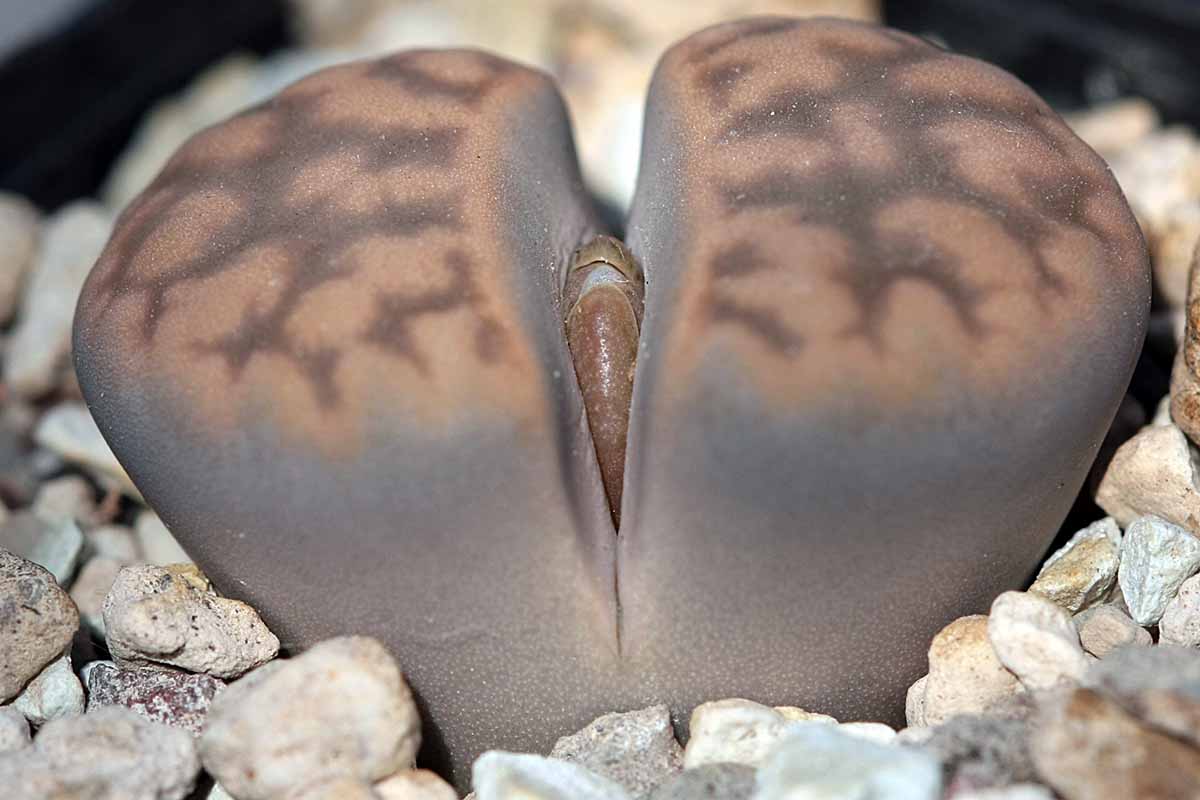
Faces tend to be kidney shaped with slightly rough surfaces and a shallow cleft between lobes.
These medium to large living stones are opaque gray or beige, with hints of yellow, blue, pink, green, orange, or reddish-brown, and have distinct margins.
Windows usually take the form of a network of broad or narrow channels marked with bold rubrications that can be red or brown. This flowers of this lithops are white.
15. Helmutii
L. helmutii has a heart shaped to double wedge shaped profile, and usually produces two to six heads but sometimes 26 or more.
Smooth faces are semi-elliptical with unequal sized lobes that have a very deep fissure and a wide gap between them.
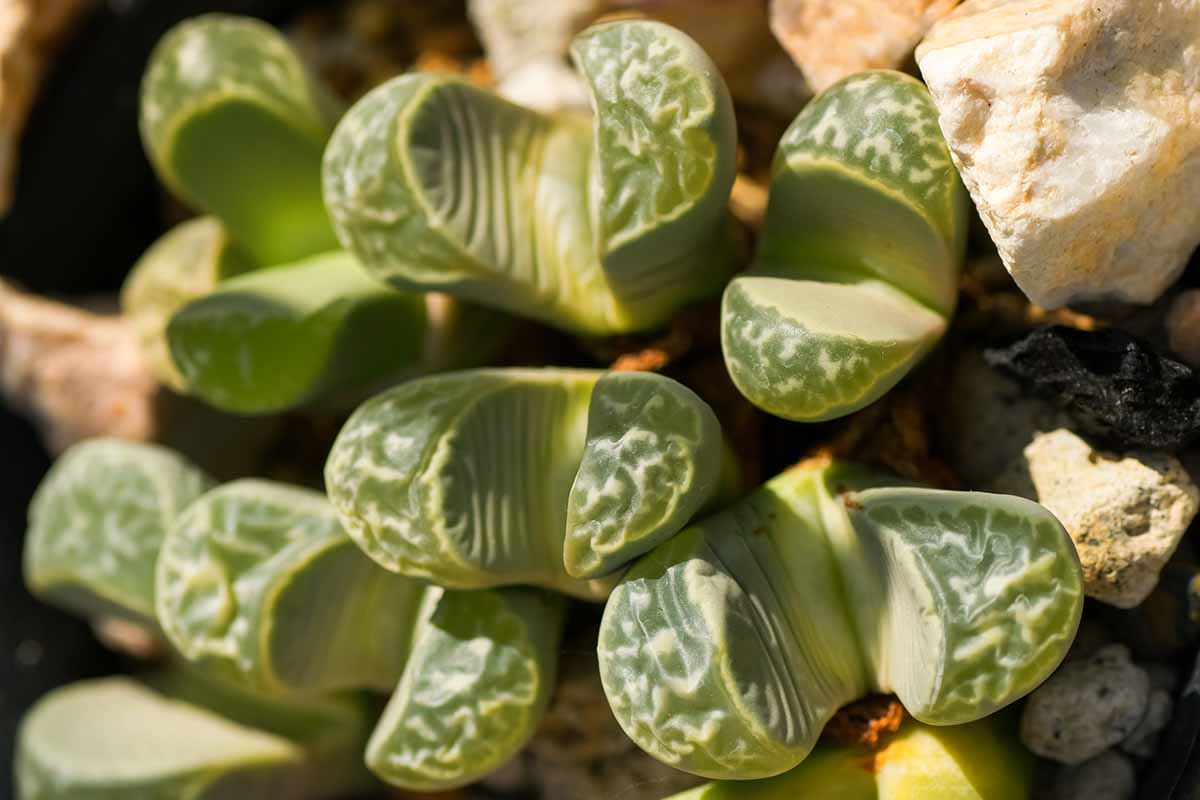
These small to medium lithops are creamy colored with tinges of green, pink, or yellow.
In L. helmutii, windows are translucent, and islands can be few or many, large or small.
The inner margins of this lithops are usually straight and its outer margins tend to be lobed.
Channels are broad to narrow, rubrications are absent, and flowers are yellow with white centers.
16. Hermetica
L. hermetica has a heart shaped profile with flat-topped or slightly convex lobes.
Usually producing just one to two heads, this living stone has semi-elliptical or slightly kidney shaped faces that may be smooth or somewhat rough.
Lobes are separated by a deep fissure with a fairly wide gap between them.

A small to medium sized species, L. hermetica appears in dark and pale gray, sometimes tinged with green or red. It has windows and channels that are dark gray or greenish-gray.
Margins and islands are very distinct, and are an opaque, pale gray color.
L. hermetica features no rubrications but has numerous dusky dots which are greenish gray in color, as well as yellow flowers.
This lithops is another one of those outliers that prefers moisture from fall to late winter, and should be watered with a spray bottle.
You can buy L. hermetica lithops in packs of 30 seeds via Amazon.
17. Herrei
Considered a synonym of L. geyeri by some, L. herrei has a heart shaped profile with convex lobes.
This living stone forms clumps of 10 to 15 heads at maturity and has semi-elliptical, smooth faces.
Lobes are separated by a somewhat deep fissure on small to medium plants that are usually grayish-green, but can also be grayish-white, light brown, or pinkish-white.
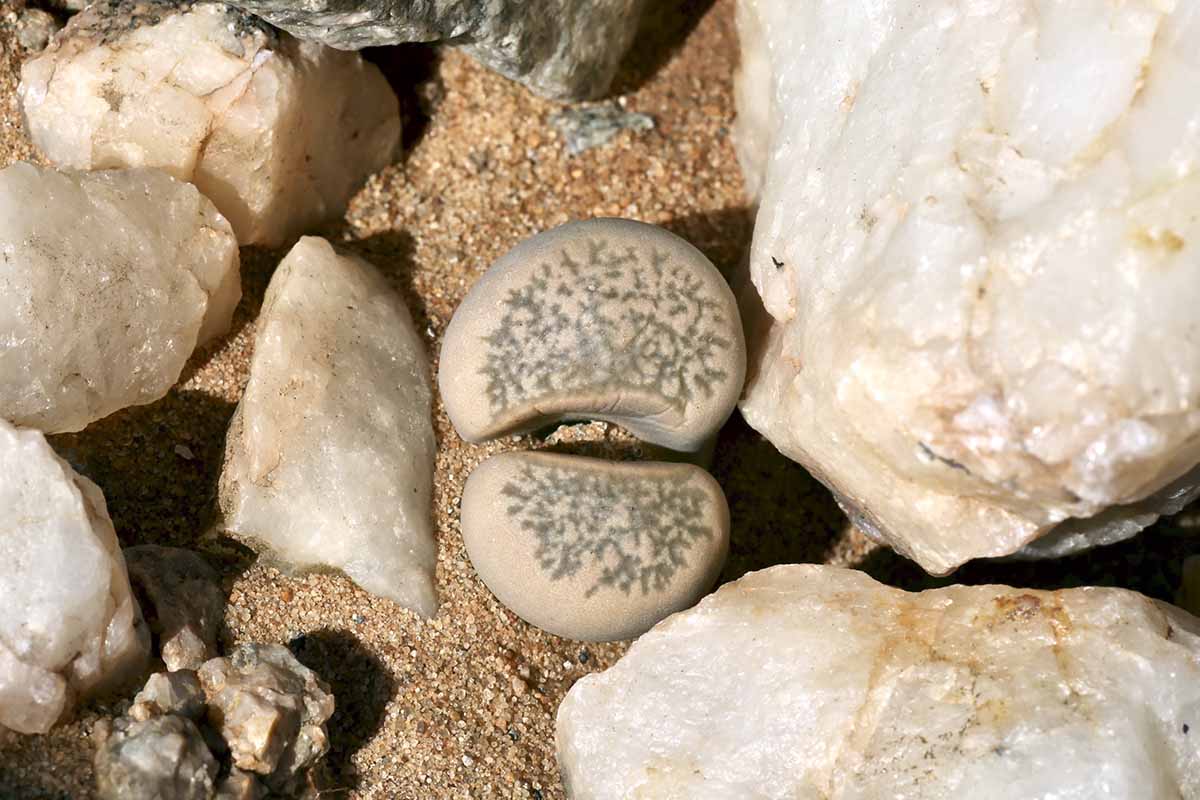
Windows can be translucent or opaque on this lithops. Margins are distinct, there are often many islands, and channels can be gray, pale blue, greenish-gray, or brownish-grayish-green.
Rubrications are absent on this living stone, and flowers are dark yellow to bronze yellow with white centers.
Depart from the “official” lithops watering schedule and instead offer this succulent light moisture from fall through late winter with the help of a spray bottle.
18. Hookeri
Awarded with the RHS Award of Garden Merit in 2002, L. hookeri has lobes that are flat topped or slightly convex.
This living stone can live as a single, solitary head, or grow in clumps of over 10 heads, though usually it matures with two to four.
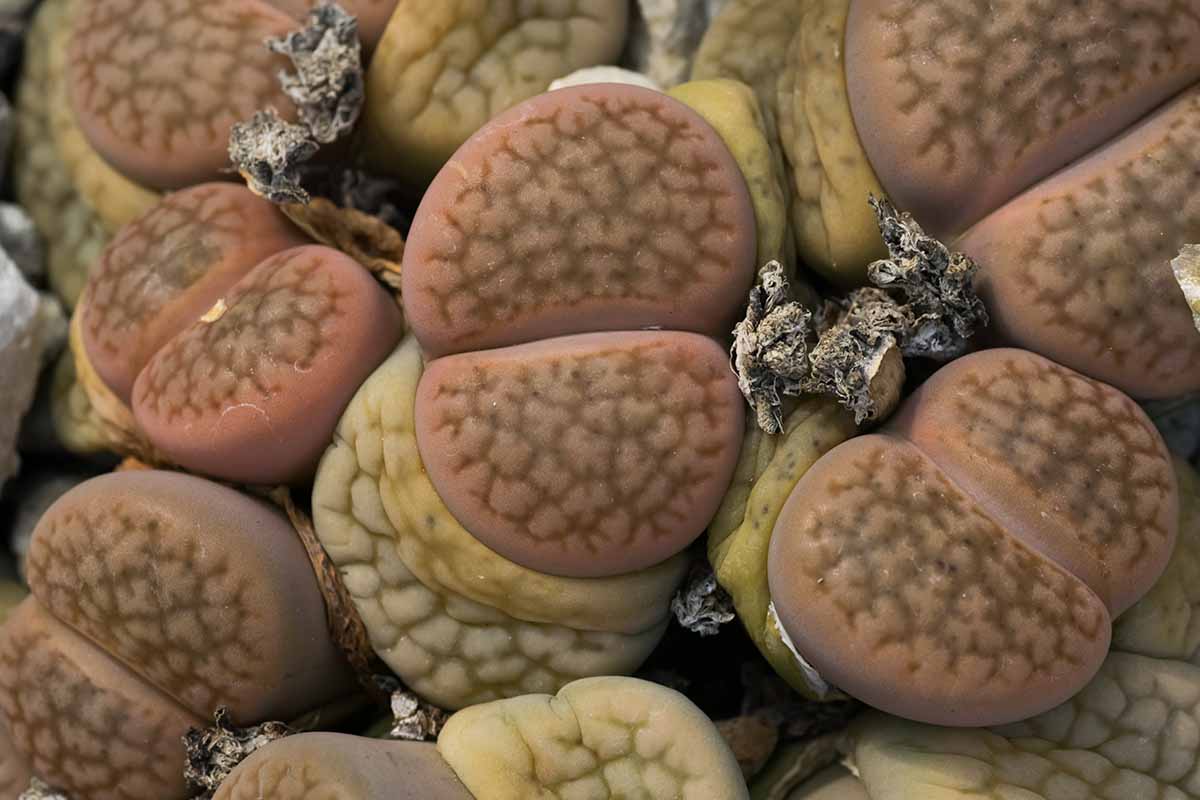
Faces are semi-elliptical, have bumpy surfaces, and are mostly the same size.
With shallow fissures, these medium to large lithops appear in opaque shades of brown, beige, or gray with windows taking on the form of reddish, pinkish, or orangish brown channels.
L. hookeri has narrow margins, rubrications, if present, in the form of dull red lines, and rarely has dusky dots as well.
Expect yellow blooms.
There are different varieties, cultivars, and forms of this lithops species. One is the “vermiculate form” which is known for its wavy, furrowed channels.
Purchase L. hookeri vermiculate form lithops in packs of 30 seeds via Amazon.
19. Julii
L. julii has flat topped to slightly convex lobes, and can grow as a solitary head or in clumps of two or more, and sometimes 15 or more.
Lobes are usually flush and slightly kidney shaped, have a smooth or textured surface, and are separated by a deep cleft.

This medium sized living stone is extremely varied in its coloration, but most plants have a milky appearance. They are often pale gray tinged with blue or pink, and some have brown markings.
Windows are obscured and some specimens have a distinctively heavier coloration on the edges of the fissure called a “lip smear,” or markings that look like stitches on the outer margin.
This lithops has wide channels and features rubrications – dots, dashes, and networks of lines.
The flowers of this succulent are white.
Find L. julii lithops seeds in packs of 10 from West Seed Farm via Amazon.
20. Karasmontana
A favorite among succulent growers, L. karasmontana was awarded the RHS Award of Garden Merit in 2002.
With lobes that are flat topped to slightly convex, this succulent usually grows in clumps of two to six heads but there are sometimes as many as 12 or more in a small clump.
Faces are semi-elliptical to kidney shaped and of unequal size, usually rough with depressions on their surfaces.
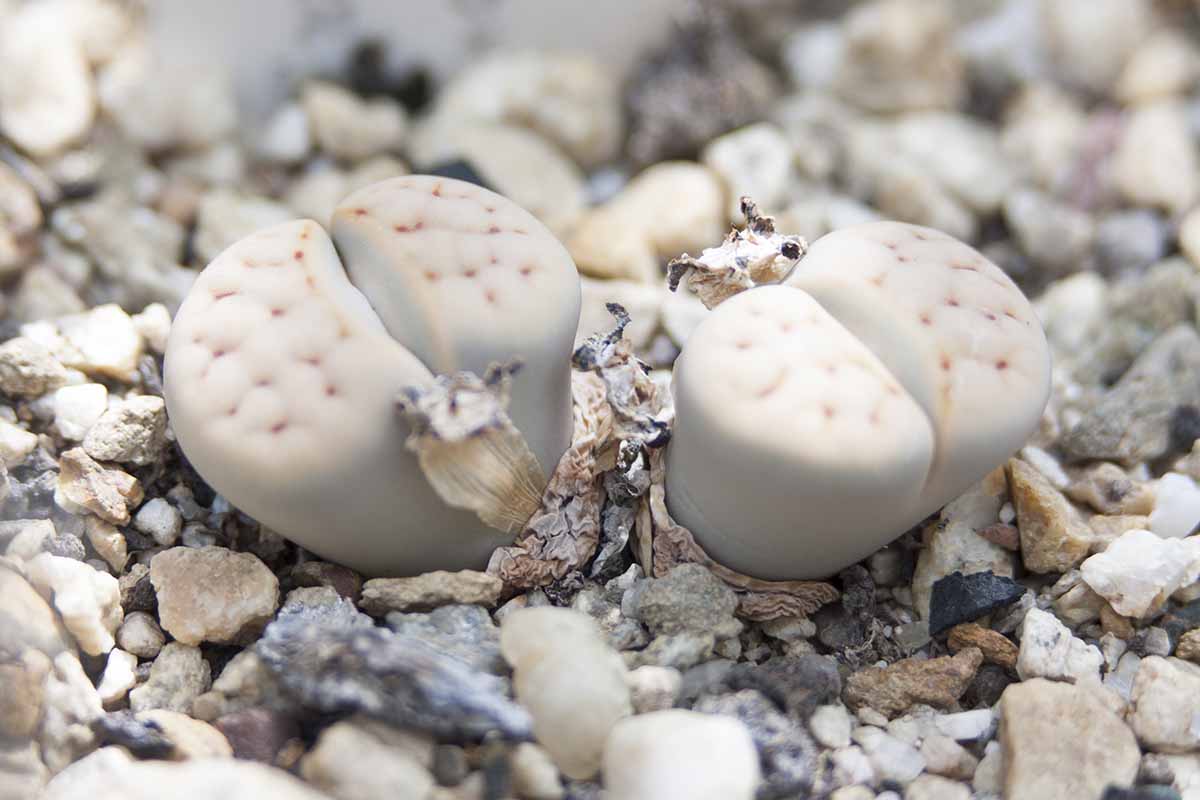
These medium to large sized living stones have a fairly deep cleft, with bodies presenting in a wide variety of colors, but frequently whitish-gray to blueish-gray.
Windows are absent or barely perceptible – when present, they are usually grayish, blueish, or brownish.
This lithops’ margins are indistinct or somewhat sunken, while channels are indented and can be either narrow or broad.
Islands are usually only vaguely apparent and rubrications, if present, show up in a network of dots, hooks, triangles, and short lines. Dusky dots are absent or hardly noticeable and flowers are white.
‘Top Red’ is a cultivar that has a gray to beige body with wide, furrowed channels that are brick red in color.
L. Karasmontana ‘Top Red’ Seeds
Purchase packs of 50 L. karasmontana ‘Top Red’ lithops seeds from Dichondra via Amazon.
21. Lesliei
Winner of the RHS Award of Garden Merit in 2002, L. lesliei has flat to slightly convex lobes, with plants growing as solitary heads or in clumps of two or more.
The smooth faces of this living stone are semi-elliptical to kidney shaped, and usually of unequal size.

With shallow clefts, these medium to large plants appear in shades of brown, green, greenish-gray, pinkish-gray, and rusty orange.
Windows are obstructed by a latticework of patterns, revealing miniature round windows and channels that are dark green, greenish-brown, or blueish-green.
This lithops’ margins are slightly raised, and rubrications are absent. Flowers are usually yellow, but are sometimes, though rarely, white.
22. Localis
L. localis is a living stone that has a heart shaped profile with flush faces.
Also known as L. terricolor, this lithops species usually produces two to five heads, but sometimes more.
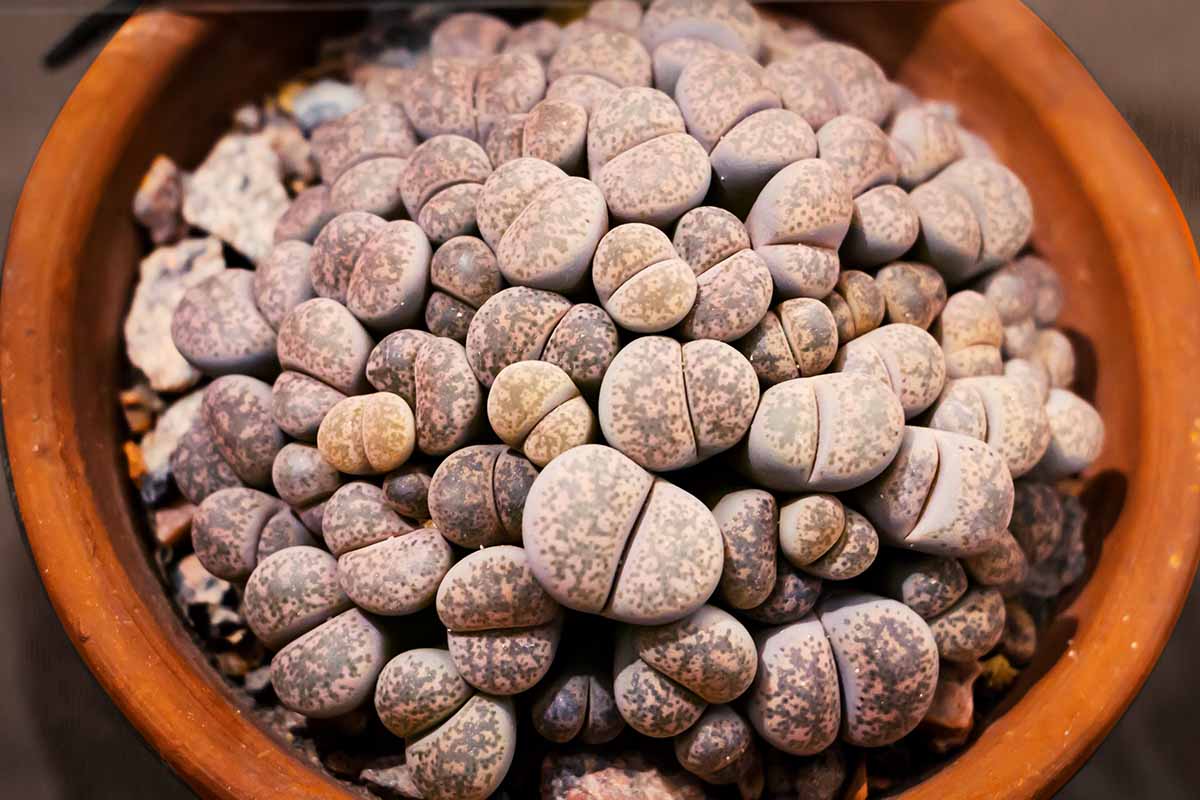
With smooth faces that are more or less semi-elliptical, this small plant has a deep fissure between its two lobes, and appears in opaque, pale shades of pink, yellow, green, blue, gray, brown and lilac.
Windows can be partly open or more or less hidden on L. localis. Margins and channels are usually not noticeable. Islands can be few or numerous and are fairly small.
There are no rubrications on this lithops, but there are numerous dusky dots. Flowers are yellow, sometimes with white centers.
23. Marmorata
L. marmorata has a heart shaped profile with flat topped to slightly convex lobes.
This multiheaded lithops often grows with just two to six heads, but sometimes produces 26 heads or more.
With semi-oval, smooth or slightly rough faces, and unequal, divergent lobes, this small to medium sized plant has a deep fissure.

This living stone has a marbled appearance with bodies in shades of opaque pale gray, blueish, greenish, cream, or pink, sometimes with tinges of light greenish-yellow, or purple.
Windows are dark, large, and mottled, usually with distinct margins and narrow to broad channels.
No rubrications will be found on this lithops, but do expect white flowers.
L. marmorata prefers winter waterings, so offer it moisture from fall through late winter.
24. Meyeri
With divergent, elongated lobes, L. meyeri is a living stone that usually appears at maturity with just two to three heads, but sometimes five.
Faces are smooth and slightly kidney shaped, with lobes separated by a deep fissure.
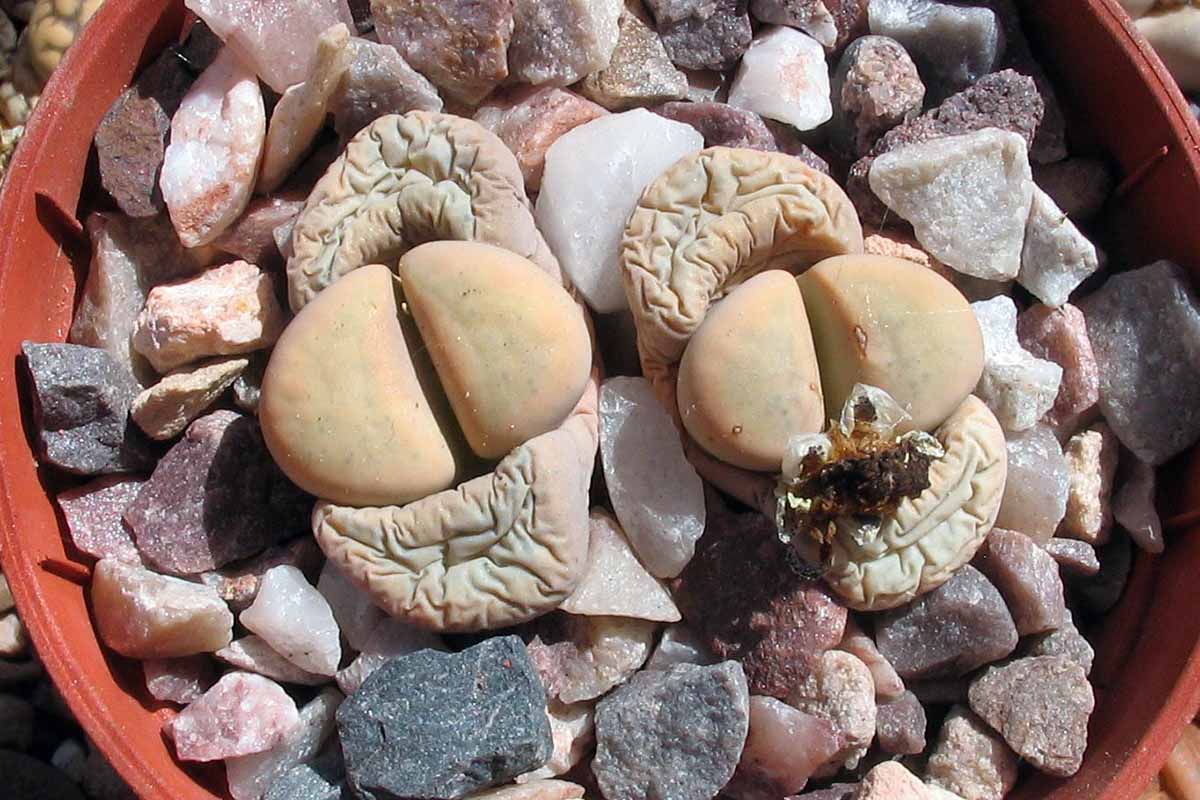
This small to large species can be found in opaque hues of white, pale creamy gray, yellow, pink, or milky green.
The windows of this plant are cloudy and hard to make out, margins and islands are not noticeable, and channels are absent or barely noticeable, appearing in a dull greenish-gray when present.
L. meyeri is rubrication free, and has yellow blooms with white centers.
This lithops thrives with very light applications of water, offered from a spray bottle, or just drops at a time.
25. Naureeniae
L. naureeniae has a profile that is double wedge shaped to heart shaped, with lobes that are either flat topped or convex, producing usually two to five heads, but sometimes over 28.
Faces are smooth and semi-elliptical, with a deep and wide fissure separating the two lobes.
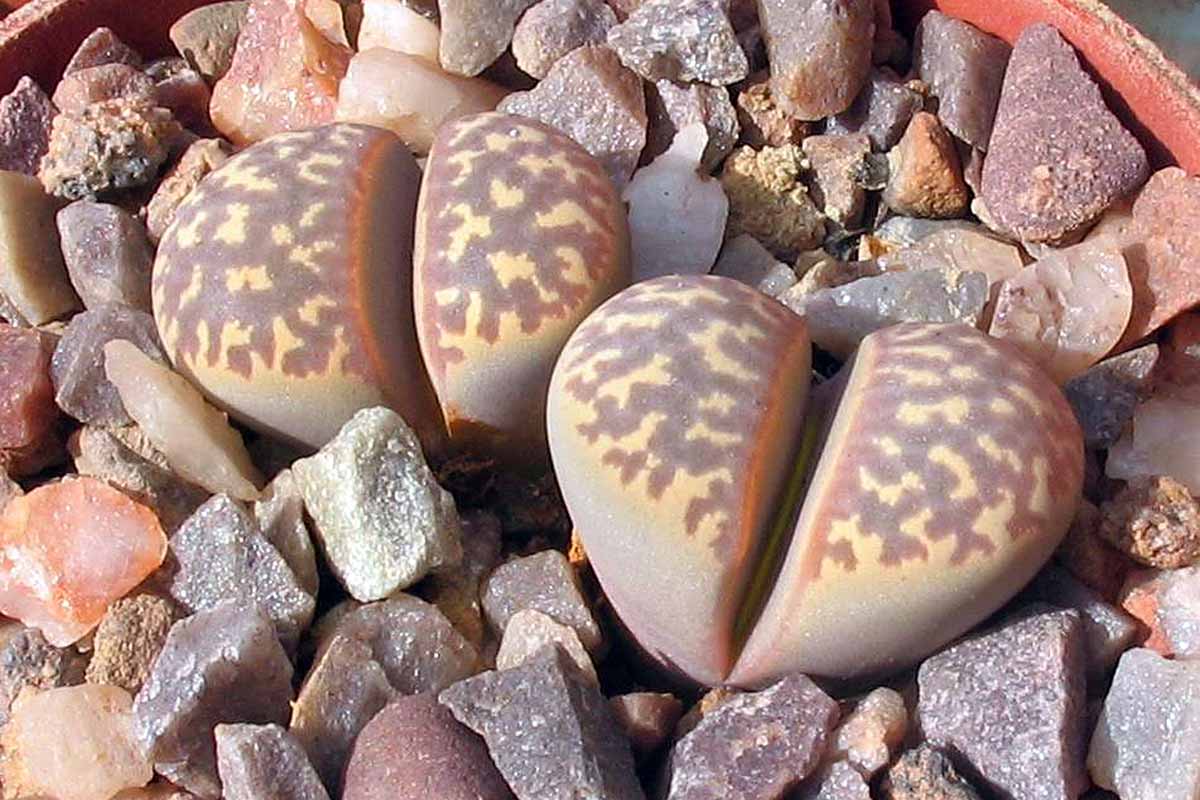
This small to medium plant is gray, beige, pink, or pale reddish-brown. Its windows are usually obstructed but are sometimes completely open, appearing in grayish-green, greenish, brownish, or reddish-gray.
Margins are distinct but narrow, sometimes with many peninsulas emerging from margins.
Islands are usually very bold on this lithops, and channels are narrow to broad.
L. naureeniae has no rubrications, and it flowers in late autumn to early winter – producing blooms that are yellow with white centers.
Water L. naureeniae from autumn through late winter.
L. Naureeniae Living Stone Seeds
Purchase packs of 30 L. naureeniae lithops seeds via Amazon.
26. Olivacea
Awarded the RHS Award of Garden Merit in 2002, L. olivacea has lobes with rounded tops and grows in clumps that can reach over 30 heads, but usually displays a more restrained three to 10.
Smooth faces are slightly divergent, with the plant taking a round or slightly elliptical shape when viewed from above.

Fissures are fairly deep between the two lobes of this small plant, which is usually colored green, gray, or salmon pink.
L. olivacea features large open windows, usually scattered with just a few small, distinct islands.
Margins are distinct, there are usually no channels, and rubrications are absent.
The flowers of this lithops are yellow with white centers.
27. Optica
L. optica has a heart shaped profile with convex, divergent lobes.
This plant usually produces two to five heads, but mature clumps can have more than 20 heads.
Faces are smooth, usually kidney shaped, and unequal sizes with deep fissures between lobes.

Small plants are grayish-green or milky pink, with windows that are usually open and usually lack islands.
Windows are dark grayish-green or ruby red, depending on the body color.
Margins are distinct, channels are absent except on one form of the plant, and rubrications are absent.
Flowers are white on this lithops, sometimes with pink tips.
Water L. optica in fall and winter with a spray bottle.
‘Rubra’ is a cultivar of the pink form of this species that is milky pink to reddish-purple with darker purple or reddish windows.
You can purchase sets of three live L. optica ‘Rubra’ lithops plants that are one to two years old from the Micro Landscape Design Store via Amazon.
28. Otzeniana
L. otzeniana has a heart shaped profile with rounded, slightly divergent lobes.
Plants usually mature to clumps of two to five heads, but can be found with as many as 25.
Faces are more or less semi-elliptic, and can be smooth or slightly rough with a deep cleft between lobes.
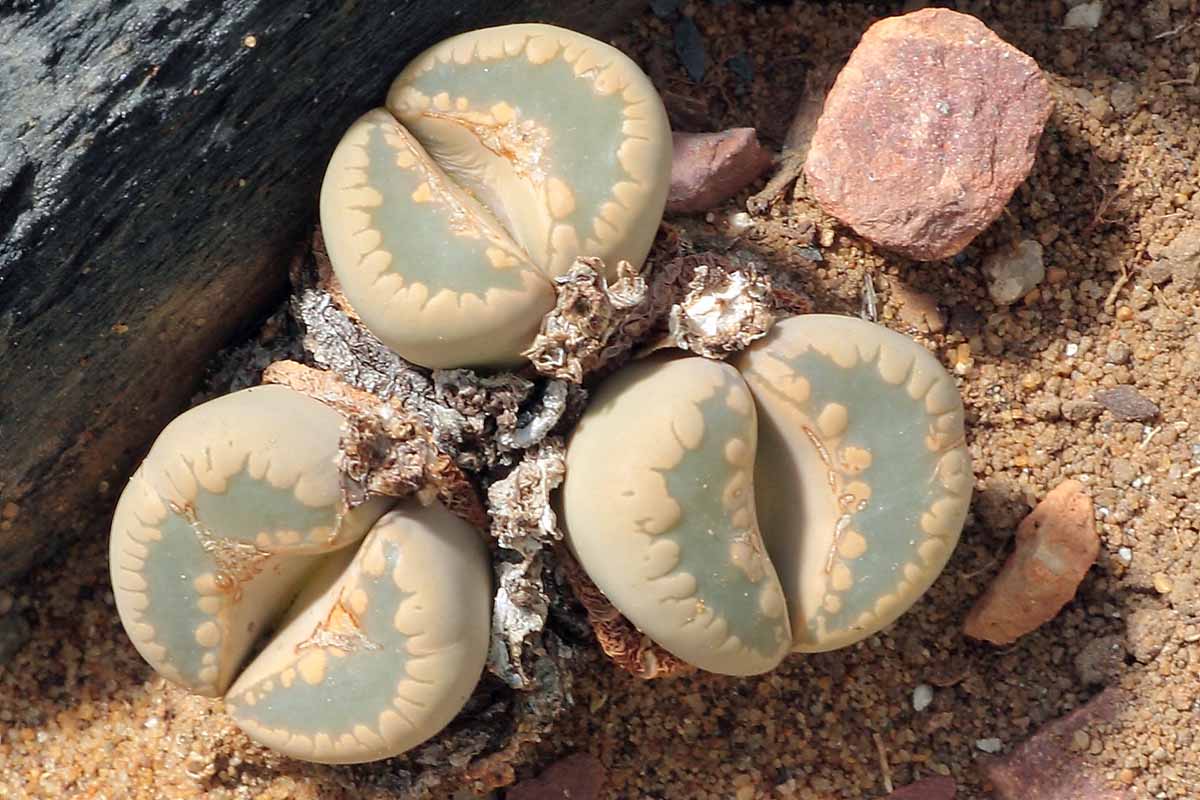
These living stones are small to medium, and are shades of gray, tinged with pink, cream, green, or blue.
This lithops is particularly easy to recognize.
For most specimens, wide windows with broad to narrow channels are bordered by distinct margins that have rounded peninsulas, grouped with scalloped islands.
Islands can be few to many, and are often quite large.
There are no rubrications on L. otzeniana, whose flowers are yellow with white centers.
This living stone should be watered lightly starting in autumn through early spring.
29. Pseudotruncatella
Winner of the RHS Award of Garden Merit in 2002, L. pseudotruncatella has flat or rounded lobes.
Mature plants usually have two to four heads, sometimes only one, and sometimes over 20 per clump.
Faces are smooth, kidney shaped, and often of unequal sizes.
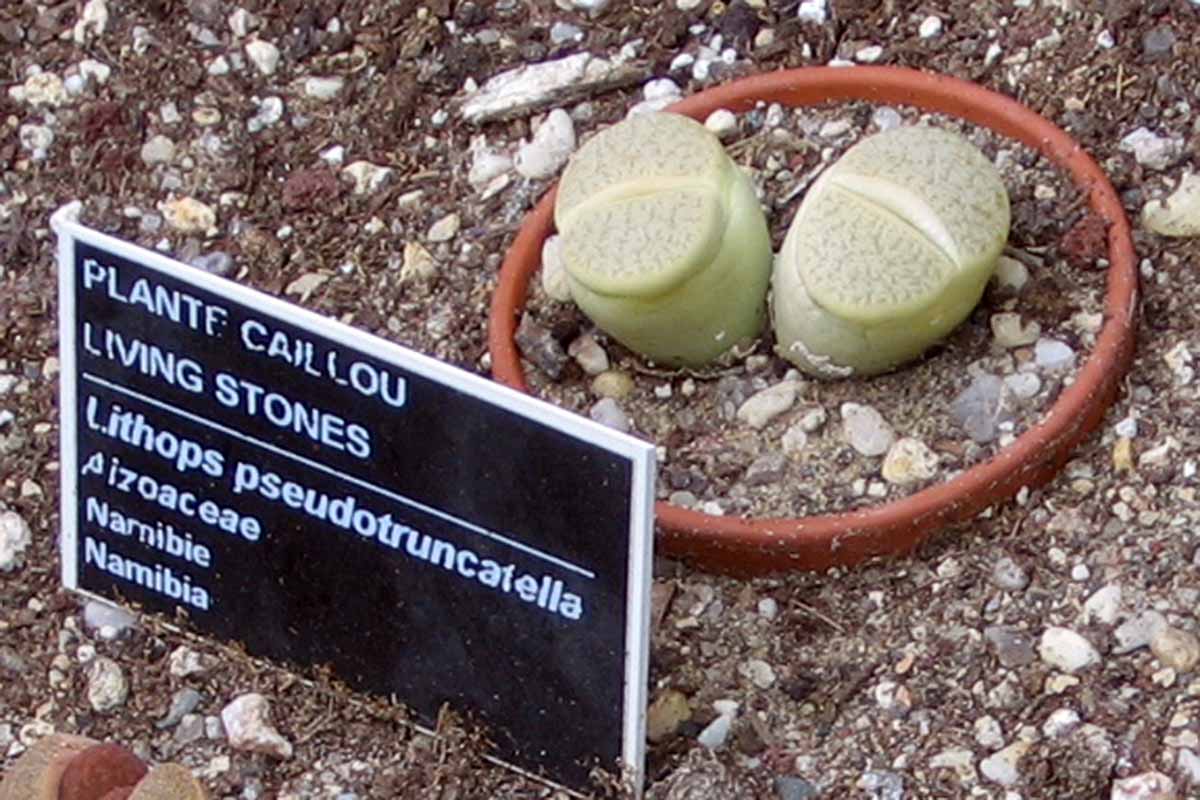
This large to very large plant has a shallow cleft between its two lobes, and appears in shades of green, pink, blue, gray, white, or beige.
This is an extremely variable species, with five subspecies and many varieties.
Windows are sometimes apparent, but are usually reduced to small round dots that have a greenish or grayish color. Margins, channels, and islands vary depending on the subspecies, but one of the common features is a branching network of rubrications.
This lithops bears yellow flowers.
30. Ruschiorum
L. ruschiorum has a heart shaped profile with convex lobes.
Mature plants usually grow in clumps of two to five heads, but can sometimes produce as many as 30.
Faces are kidney shaped with smooth or slightly rough surfaces.

Medium sized plants have a deep fissure and opaque faces that are cream colored or grayish, yellowish, or pinkish-white.
Windows and margins are absent, and channels are usually missing as well. When channels are present, they appear as a disconnected network of grooves and pits, sometimes marked with rubrications.
L. ruschiorum bears lovely yellow flowers.
Plan on giving this lithops water from fall to late winter, preferably via a spray bottle.
31. Salicola
With a flat-topped profile, L. salicola was bestowed with the RHS Award of Garden Merit in 2002.
This plant usually counts two to five heads at maturity, but can sometimes produce over 50!
Smooth faces are kidney shaped, giving the plant an elliptical form when viewed from above.
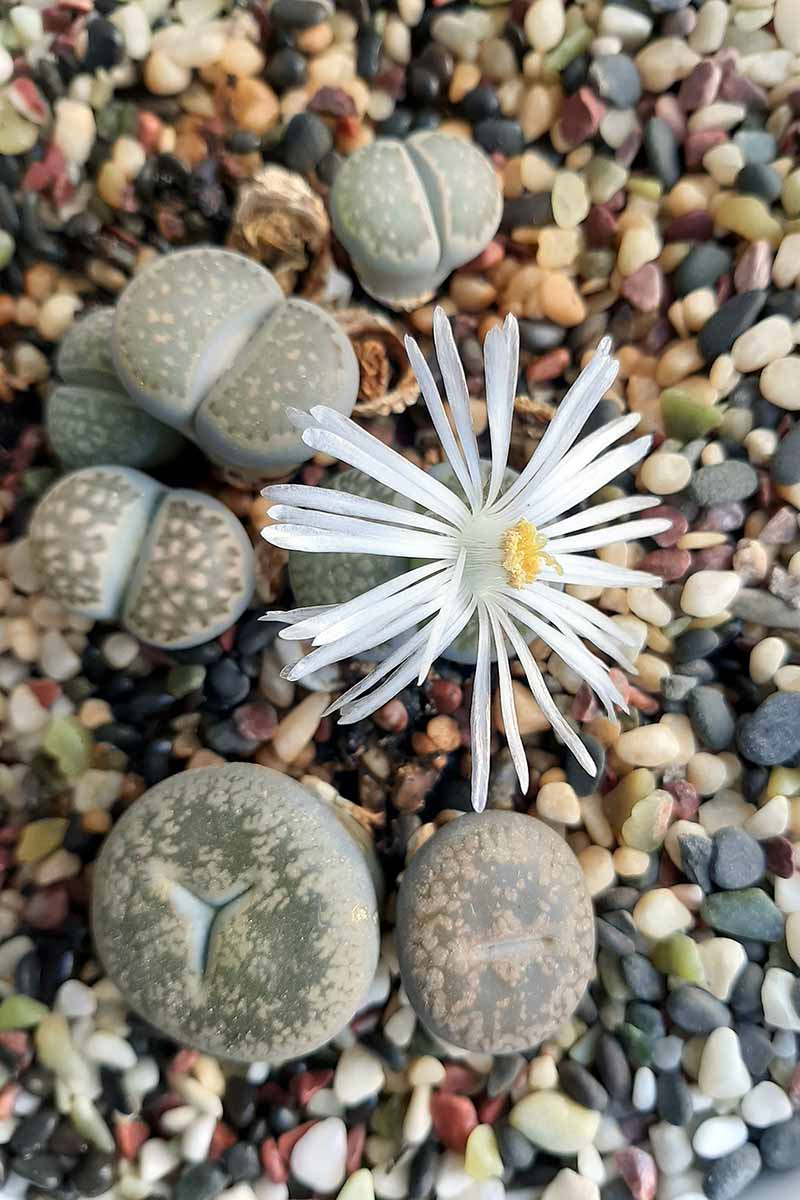
These plants are tiny to small and have shallow clefts between their lobes.
They usually appear in shades of opaque gray tinged with green, yellow, pink, or lilac, and tend to have open windows.
Margins are distinct and channels are usually absent on this lithops, but when present they are broad to narrow.
There are usually no rubrications on L. salicola, which bears white flowers.
L. Salicola Living Stone Plants
Purchase live L. salicola living stone plants from CTS Air Plants via Amazon.
There are different varieties, forms, and cultivars of L. salicola – one is known as the maculate form, which has large, striking windows, scattered with distinct islands.
Another option of interest, L. salicola ‘Sato’s Violet’ is a cultivar of this species that is loved by succulent fans, being one of the few brightly colored lithops.
Also known as L. salicola cv. Bacchus, this cultivar is the color of red wine and has open windows.
Purchase sets of three L. salicola ‘Sato’s Violet’ live lithops plants from the Micro Landscape Design Store via Amazon.
32. Schwantesii
Winner of the RHS Award of Garden Merit in 2002, L schwantesii has a flat-topped profile, and is usually found with just one to three heads, but can sometimes form clumps of over 15.
Viewed from above, plants have an elliptical form, with kidney shaped faces that have smooth or rough surfaces.
Medium sized plants have shallow fissures and appear in shades of gray, yellow, or brown, with opaque or translucent grayish green windows, depending on the subspecies.

The margins on this succulent are not well defined, and plants feature channels that are either fine networks of grooves or broad and translucent.
This lithops has rubrications, in the form of a connected or broken network of lines, dashes, hooks, and dots.
Flowers are yellow on these plants. Of note, unlike most species whose old leaves dry up as new ones emerge, the still plump old leaves remain on these plants after new leaves emerge for up to one to two years.
33. Vallis-Mariae
L. vallis-mariae has slightly convex lobes, and produces two to four heads but sometimes 10 or more.
Faces are more or less kidney shaped, with slightly rough surfaces. They have either tiny wrinkles or are slightly pitted, which is a distinctive feature of this species.
Medium sized plants have a shallow cleft and are an opaque pale grayish-white color, sometimes tinged with hints of beige, green, pink, or yellow.
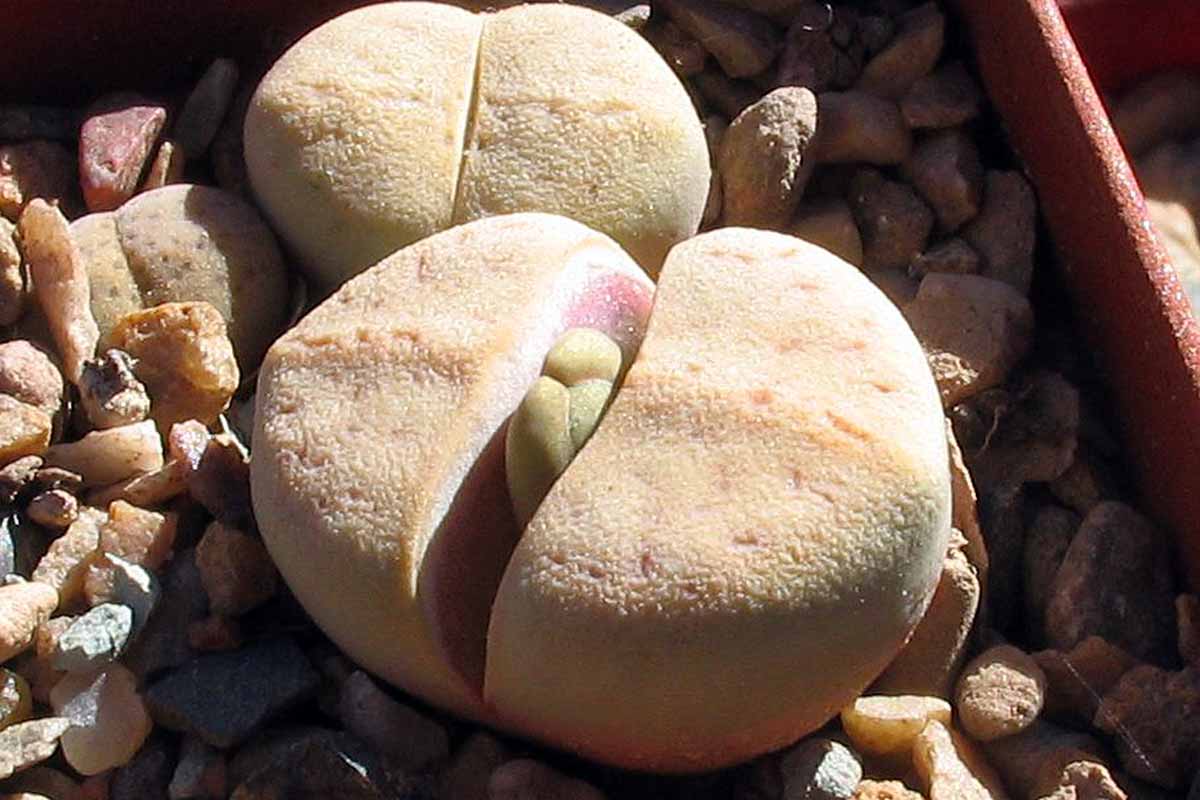
The windows are absent or are very hidden, margins are absent or are very opaque, and there are often no channels.
When channels are present they are usually opaque in shades of gray, blueish-gray, pinkish-gray, or pinkish-brown, and are sometimes indented. No rubrications are present on this lithops.
Flowers are usually yellow, but are sometimes orangish-yellow, and sometimes tinged with bronze or pink.
34. Verruculosa
L. verruculosa is a flat-topped species that produces two to four heads at maturity, but sometimes is found in clumps of up to eight heads.
Usually the faces have distinct kidney shapes, slightly rough to rough surfaces, and can be quite uneven in size.
These small to medium sized plants have a shallow cleft and appear in opaque gray or beige with tinges of blue, brown, green, pink, or yellow.
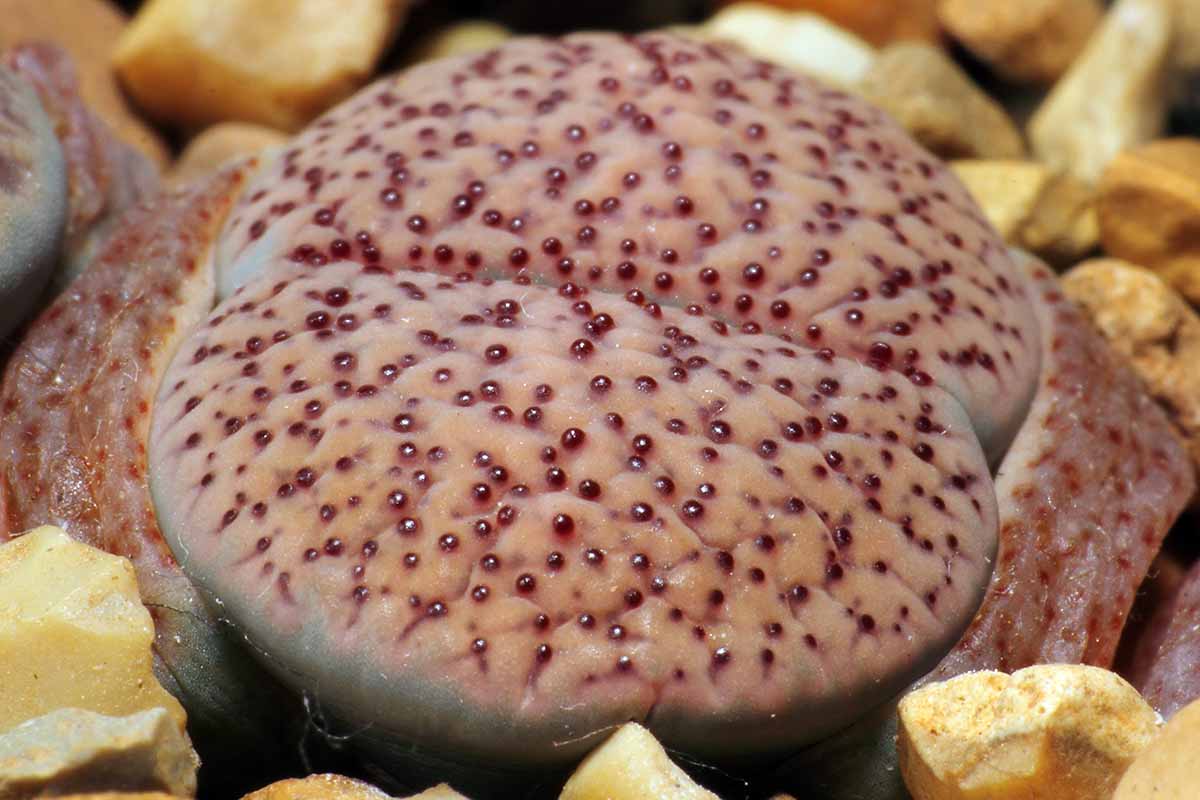
Windows are usually not noticeable, but are sometimes completely open.
In specimens with open windows, margins tend to be well defined but otherwise they are not obvious.
Channels are broad to narrow, in translucent shades of gray, brown, green, red, or blue.
Inspiring the plant’s species name, distinctive raised, red dots that look like warts or pimples usually grace the surface of L. verruculosa. These raised dots are rubrications.
The flower color in this succulent varies greatly – they can be white, yellow, orange, bronze, or shades of pink.
‘Rose of Texas’ is a cultivar of L. verruculosa that always produces pink flowers.
35. Villetii
L. villetii has a heart shaped profile, usually producing two to four heads, but sometimes up to seven.
With an elliptical form and kidney-shaped faces that are smooth or slightly rough, this small to medium plant has a shallow fissure.

Found in shades of green, yellow, gray, brown, pink, or mauve, L. villetii has large clear windows that feature small islands which can be few in number or quite numerous.
Distinct margins are somewhat raised in texture, while channels tend to be narrow.
There are no rubrications on this lithops, which bears white flowers.
36. Viridis
L. viridis has a heart shaped profile, with mature plants usually displaying two to four heads, but sometimes up to eight.
Viewed from above, the plant has an elliptic shape, with smooth faces and a deep fissure between the two lobes.

Plants are small and colored opaque grayish pink, cream, beige, or green hues.
This lithops’ open windows usually have green tones and are translucent, with distinct margins.
There are no channels or rubrications, and flowers are yellow with white centers.
Water L. viridis lightly from fall to early spring.
37. Werneri
L. werneri has flat topped lobes with a heart shaped profile.
Mature plants usually have just two to three heads, but sometimes exist in clumps of up to 10.
The two slightly rough faces make an elliptic shape and are separated by a fairly deep fissure.
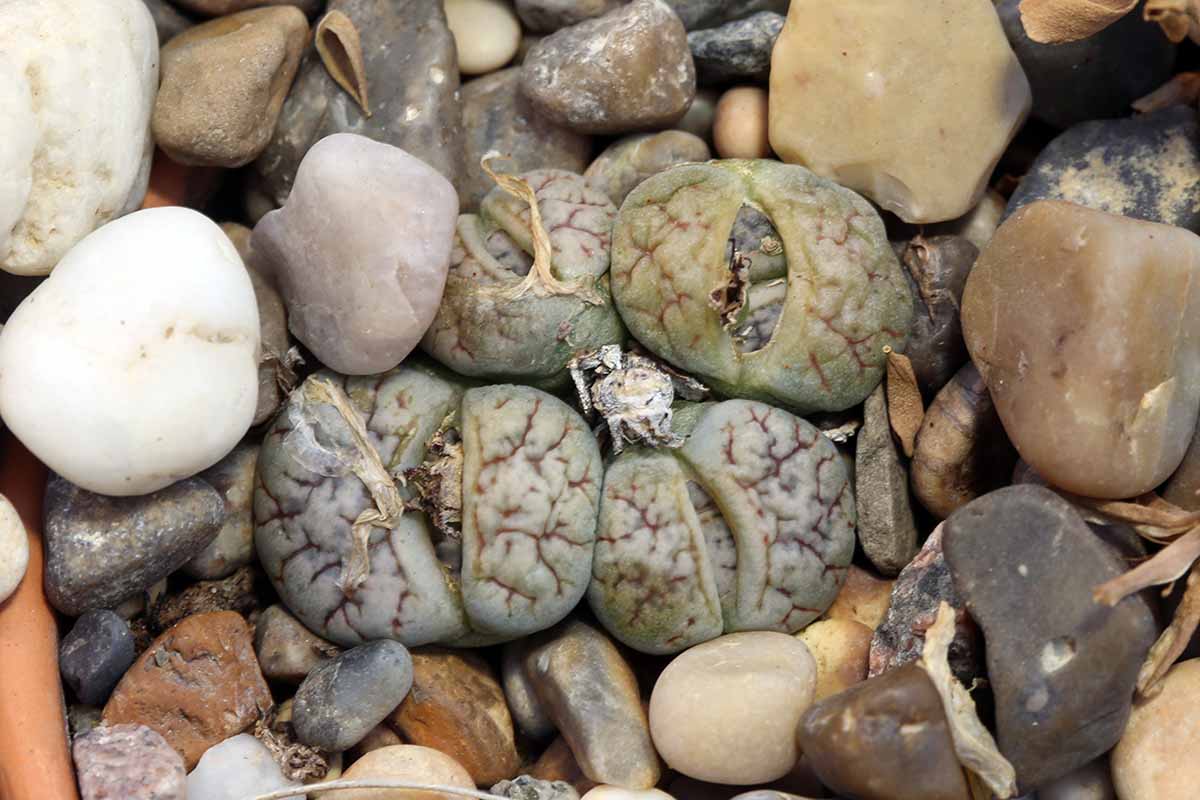
Small plants are opaque and light gray, or greenish, pinkish, or yellowish gray.
Windows are either not noticeable at all or present as broad or narrow channels. The outer margin is usually not distinct while the inner margin is generally a continuous line.
This lithops’ channels are furrowed, and there are rubrications and dusky dots as well.
Expect yellow flowers from L. werneri.
A World of Beautiful Living Stones
Our exploration of the diminutive world of lithops has come to an end!
Rather than taking inspiration from this assemblage to create your own vast collection of these plants, why not use this comparison to hone in on one or two lithops that you’re particularly fond of?

I’ll confess that the pink and green hues of some L. villetii specimens are the ones that I’ll be making space for on my windowsills. So, if you had to pick just one lithops, which is your favorite? Let us know in the comments section!
And if you’d like help identifying a living stone whose identity you’re not sure about, be sure to post a few (very clear!) photos so we can try to help you put a name to your lithops – we’re always up for a challenge.
Care to expand your journey of the world of cacti and succulents? There’s more to discover right here:











